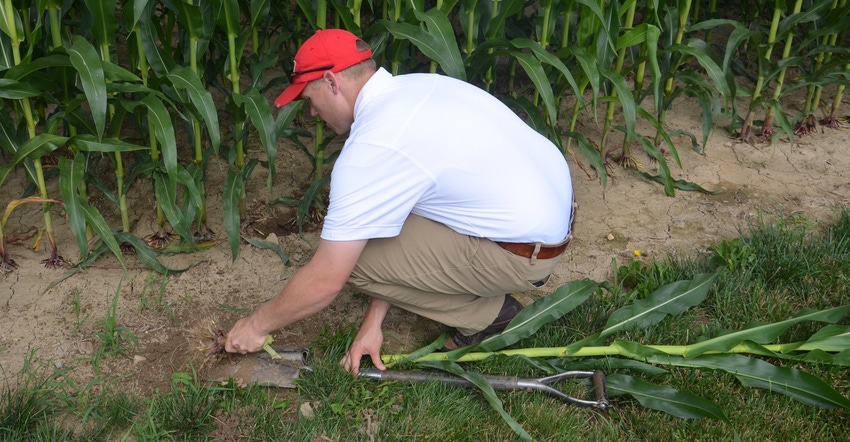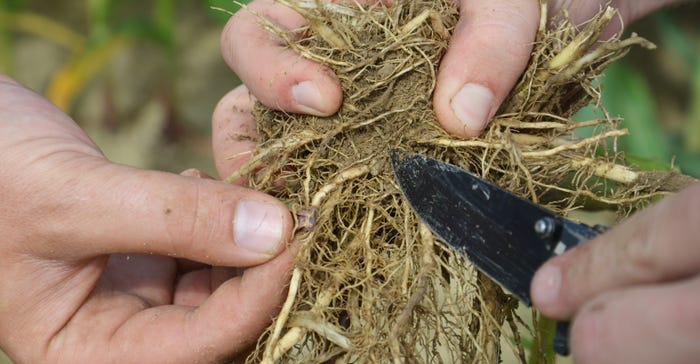
Soybeans bring evidence of planting depth with them when they emerge. The seed becomes the cotyledon above ground. Corn is a different story, however. Corn seed stays right where it was placed all season.
Derek Reusser says that makes it possible to determine original seeding depth for any corn plant at any time, all the way until harvest. If you sacrifice a plant and dig up its roots, you can determine seeding depth.
“We believe it’s very important to go into your fields and scout, and monitor planter performance,” says Reusser, a product specialist with Agco. “We have tremendous technology today which monitors performance while you’re planting. Using that technology makes it easier to do a good job of planting.
“But there’s still no replacement for going into the field later and checking performance. Even with all our technology, we’re never going to replace the agronomist.”
Reusser and Craig Unverferth, an Agco field product specialist, regularly evaluate an Agco Crop Tour plot in a farmer’s field near Union City, Ohio. They worked with the farmer on 40 acres of corn to plant various demonstrations that illustrate the importance of setting planters correctly. The plot will be open for tours on Aug. 14. Contact an Agco or Precision Planting dealer for details.
Measure seed depth
Reusser dug up a plant to show how you can determine seed depth at any time in the season. He cut off the lower section of the stalk. Then he located the seed.
With Unverferth’s assistance, he illustrated how to determine depth of planting. “Simply locate the seed; then measure the length of the root from the seed back up to the underneath side of the base of the plant,” he explained. “Add three-fourths of an inch. The final number tells you original planting depth for that seed.”
 DETERMINE DEPTH: No, Derek Reusser doesn’t have three hands! Craig Unverferth of Agco is helping him. Reusser illustrates where to measure the root above the seed; then add three-fourths of an inch to determine original seeding depth.
DETERMINE DEPTH: No, Derek Reusser doesn’t have three hands! Craig Unverferth of Agco is helping him. Reusser illustrates where to measure the root above the seed; then add three-fourths of an inch to determine original seeding depth.

On the plant Reusser dug up for demonstration purposes, the depth came out to roughly 2 inches. That’s a common seeding depth, but some farmers plant deeper today. One demonstration at the Union City plot compares planting depths from 1 inch to more than 3 inches.
Based on past demonstrations in the Agco Crop Tour program in 2016 and 2017, there may not be much difference in yield for corn planted at 2 inches or 3 inches deep, Reusser notes. The question mark often comes with the 1-inch depth.
The risk is that if seed is planted only 1 inch deep, depending on weather and soil conditions, not every seed ends up in moisture. When seeds are placed in uneven moisture levels, emergence usually isn’t uniform.
One factor new SmartFirmer technology by Precision Planting measures is moisture in the seed trench. If it’s too low, it’s an indication to plant deeper.
About the Author(s)
You May Also Like




